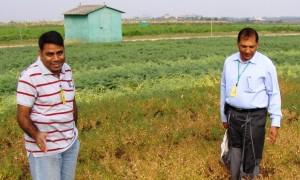BREAK-TIME AND BRAKE-TIME from beans for a bit: Steve Beebe takes a pause to strike a pose in a bean field.
“These [molecular breeding] techniques, combined with conventional methods, shorten the time it takes to breed improved varieties that simultaneoulsy combine several traits.
And this means that we also get them out to farmers more quickly compared to phenotypic selection alone.”
– Steve Beebe
THE NEAR-PERFECT FOOD: Common beans (Phaseolus vulgaris L) comprise the world’s most important food legume, feeding about 200 million people in sub-Saharan Africa alone. Their nutritional value is so high, they have been termed ‘a near-perfect food’. They are also easy to grow, adapting readily to different cropping systems and maturing quickly.
That said, this otherwise versatile, adaptable and dapper dicotyledon does have some inherent drawbacks and ailments that crop science seeks to cure….
Rains are rapidly retreating, and drought doggedly advancing
Despite the crop’s widespread cultivation in Africa, “yields are low, stagnating at between 20 and 30 percent of their potential,” remarks Steve Beebe, GCP’s Product Delivery Coordinator for beans, and a researcher at the International Center for Tropical Agriculture (CIAT, by its Spanish acronym).
“The main problem is drought, brought about by climate change,” he says. “And it’s spreading – it already affects 70 percent of Africa’s major bean-producing regions.” Drought decimates bean harvests in most of Eastern Africa, but is particularly severe in the mid-altitudes of Ethiopia, Kenya, Tanzania, Malawi and Zimbabwe, as well as in southern Africa as a whole.
Drought, doubt and duality − Diversity a double-edged sword
“Common beans can tolerate drought to some extent, using various mechanisms that differ from variety to variety,” explains Steve. But breeding for drought resistance is complicated by the thousands of bean varieties that are available. They differ considerably according to growth habit, seed colour, shape, size and cooking qualities, and cultivation characteristics.
“A variety might be fantastic in resisting drought,” says Steve, ‘but if its plant type demands extra work, the farmers won’t grow it,” he explains. “Likewise, if consumers don’t like the seed colour, or the beans take too long to cook, then they won’t buy.”
Molecular breeding deals a hand, waves a wand, and weaves a band
This is where molecular breeding techniques come in handy, deftly dealing with the complexities of breeding drought-resistant beans that also meet farmer and consumer preferences. No guesswork about it: molecular breeding rapidly and precisely gets to the heart of the matter, and helps weave all these different ‘strands’ together.
The bean research team has developed ‘genetic stocks’, or strains of beans that are crossed with the varieties favoured by farmers and consumers. The ‘crosses’ are made so that the gene or genes with the desired trait are incorporated into the preferred varieties.
The resulting new varieties are then evaluated for their performance in different environments throughout eastern and southern Africa, with particular focus on Ethiopia, Kenya, Malawi and Zimbabwe which are the target countries of the Tropical Legumes I (TLI) project.
GCP supported this foundation work to develop these molecular markers. This type of breeding – known in breeder parlance as marker-assisted selection (MAS) – was also successfully used to combine and aggregate resistance to drought; to pests such as bean stem maggot (BSM); and to diseases such as bean common mosaic necrosis potyvirus (BCNMV) and to bruchid or common bacterial blight (CBB). The resulting ‘combinations’ laden with all this good stuff were then bred into commercial-type bean lines.
“These techniques, combined with conventional methods, shorten the time it takes to breed improved varieties that simultaneoulsy combine several traits,” comments Steve. “This means that we also get them out to farmers more quickly compared to phenotypic selection alone.”
Informed by history and reality
Breeding new useful varieties is greatly aided by first understanding the crop’s genetic diversity, and by always staying connected with the reality on the ground: earlier foundation work facilitated by GCP surfaced the diversity in the bean varieties that farmers grow, and how that diversity could then be broadened with genes to resist drought, pests and disease.
What next?
Over the remaining two years of Phase II of the Tropical Legumes I (TLI) project, the bean team will use the genetic tools and breeding populations to incorporate drought tolerance into farmer- and market-preferred varieties. “Hence, productivity levels on smallholder farms are expected to increase significantly,” says Steve.
Partnerships
 The work on beans is led by CIAT, working in partnership with Ethiopia’s South Agricultural Research Institute (SARI), the Kenya Agricultural Research Institute (KARI), Malawi’s Department of Agricultural Research and Technical Services (DARTS) and Zimbabwe’s Crop Breeding Institute (CBI) of the Department of Research and Specialist Services (DR&SS).
The work on beans is led by CIAT, working in partnership with Ethiopia’s South Agricultural Research Institute (SARI), the Kenya Agricultural Research Institute (KARI), Malawi’s Department of Agricultural Research and Technical Services (DARTS) and Zimbabwe’s Crop Breeding Institute (CBI) of the Department of Research and Specialist Services (DR&SS).
Other close collaborators include the eastern, central and southern Africa regional bean research networks (ECABREN and SABRN, their acronyms) which are components of the Pan-African Bean Research Alliance (PABRA). Cornell University (USA) is also involved.
VIDEO: Steve talks about what has been achieved so far in bean research, and what remains to be done
Links
- VIDEO: The ABCs of bean breeding – Steve is joined by other bean breeding experts to discuss the basics of bean research
- Bean research within the Legumes Research Initiative
- Steve Beebe’s profile
- BLOGPOSTS: Bean research in Ethiopia and Zimbabwe
- OPEN ACCESS BOOK CHAPTER: How to phenotype beans for drought (by Steve Beebe et al)
- Browse our searchable Product Catalogue for bean products by keying in ‘beans’ in the search panel
- Bean facts and figures
- Join the community of bean researchers
- Making the business case for molecular breeding − an economic analysis in comparisoon with conventional breeding















